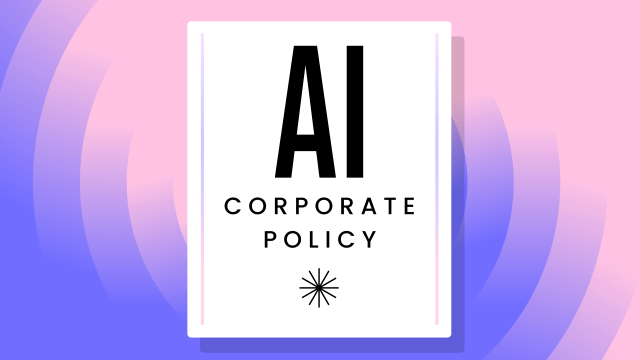Enterprise transformation
– 23 min read
Agentic AI adoption: A leader’s roadmap to enterprise governance and AI training for employees
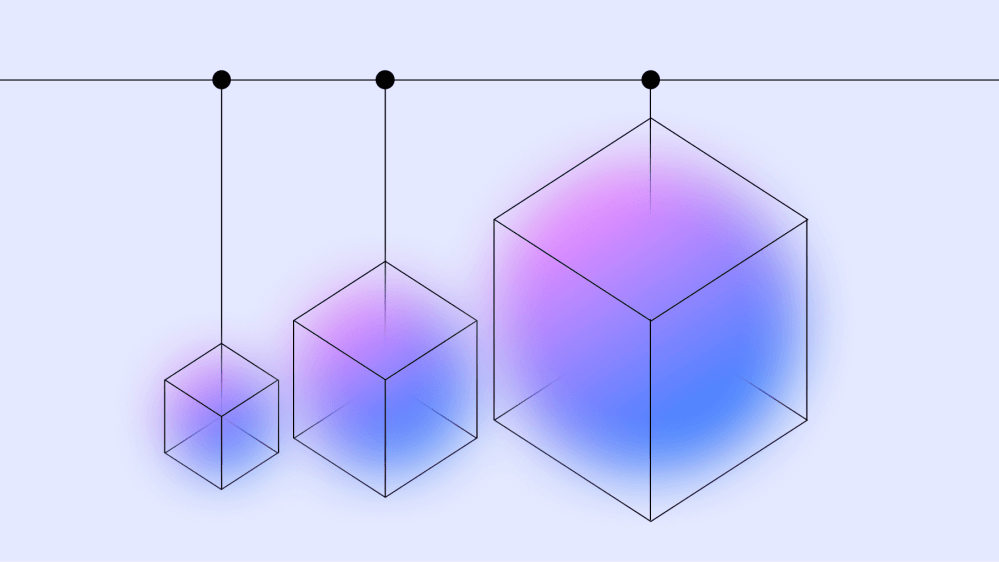
Start with simple steps before taking on complex AI systems. Use a step-by-step plan to guide your organization from basic assistive tools to advanced AI agents, making sure the process is manageable and focuses on a good return on investment.
- Unsanctioned “shadow AI” use is creating chaos — a formal adoption strategy is no longer optional for enterprises seeking to scale securely and effectively.
- Implement a “Crawl, Walk, Run, Fly” framework to guide your organization from simple assistive agents to complex, orchestrated AI systems, ensuring a manageable, ROI-focused journey.
- Go beyond AI fundamentals by upskilling employees in strategic agent design, transforming them from passive users into active citizen automators who can build their own workflows.
- Set up a cross-functional Center of Excellence (CoE) to guide strategy and invest in a unified AI platform with technical guardrails for secure, large-scale AI governance.
- To unlock agentic AI’s potential, we need to move from simple prompt engineering to whole-system agent design. This means designing complex automated processes that meet critical business goals.
The enterprise rush toward AI adoption is creating a seismic shift in the modern workplace, but not without significant turmoil. According to WRITER’s 2025 enterprise AI adoption report, a startling 68% of C-suite executives report that this rapid integration has sparked division within their organizations, with 42% stating it’s tearing their companies apart. This internal friction highlights a critical gap — while the potential of artificial intelligence is clear, the roadmap for its safe and effective implementation is not.
Agentic AI is a class of artificial intelligence systems capable of autonomously planning and executing complex, multi-step tasks across different applications to achieve a specific goal. As business leaders move beyond simple repetitive task automation and into the realm of agentic AI, the need for a governance framework becomes even stronger. The challenge for large companies is no longer just about encouraging AI adoption, but about architecting an AI strategy that mitigates risk, aligns teams, and helps organizations realize true competitive advantage. To address these challenges, companies develop effective AI employee training programs that ensure ethical use, data security, and operational competence in AI integration.
This guide provides a practical roadmap for that journey. We’ll move beyond the hype and offer a deep dive into the phased “crawl, walk, run, fly” approach to embracing AI, explore the critical shift in AI talent from prompt engineering to agent design, and detail how to establish the governance necessary for safe agentic AI at scale throughout your entire workforce.
The starting point: A company-wide AI strategy
Before we can expect employees to become AI champions, they need to understand the ground rules. The problem is, many are already using AI tools discretely — a problem known as “shadow AI.” Shadow AI refers to the unsanctioned use of artificial intelligence tools and features by employees within an organization, often without the knowledge or approval of the IT department. And it’s a bigger deal than you might think. WRITER’s same 2025 report found that 35% of employees pay out-of-pocket for the AI tools they use at work, creating further security risks. This unauthorized usage not only creates additional security AI risks, but also highlights the need for organizations to provide sanctioned and secure alternatives.
To avoid common pitfalls and security incidents that could damage your brand reputation and compromise sensitive customer data, you need a solid plan in place. That’s where a clear AI strategy and comprehensive policy come in. Enterprises without a formal AI strategy report only 37% success in AI adoption, compared to 80% for those with a strategy. This foundational document guides employees, helping them to avoid common pitfalls and prevent security incidents that could damage brand reputation and compromise sensitive customer data. Importantly, your policy should explicitly address ethics and responsible use of AI, ensuring that all employees understand the importance of ethical considerations and safe practices when working with AI tools.
This cross-functional collaboration is the heart of effective AI governance. This strategy demands bringing together the brightest minds from every corner of your business — HR leaders who understand people dynamics, legal experts who can navigate regulatory minefields, sales teams who know customer needs, marketing strategists who grasp brand implications, operations leaders who see the big picture, and IT specialists who understand the technical realities. Together, they’ll forge a policy that’s both comprehensive and actionable.
This policy should be a living document, subject to regular updates as AI evolves. Crucially, the policy must be accompanied by personalized training and clear expectations, like dedicated training modules and live sessions, to make sure every member of the organization understands and adheres to the guidelines. Regular updates should also address potential biases in AI systems, ensuring ongoing training and policy refinement to promote fairness and transparency.
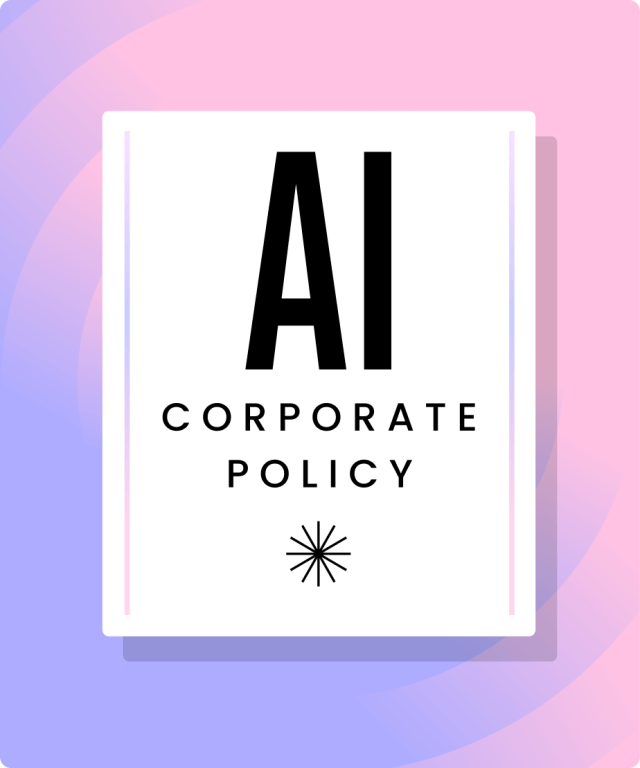
Download the template
A phased approach to adopting AI
Think of your agentic adoption journey as a “crawl, walk, run, fly” progression. You don’t need to ‘fly” on day one. The smartest approach is to start with simple, high-value automations and scale your ambition as you build momentum and prove ROI. This framework categorizes agents by their capabilities alongside real-world examples, giving you a clear path forward.
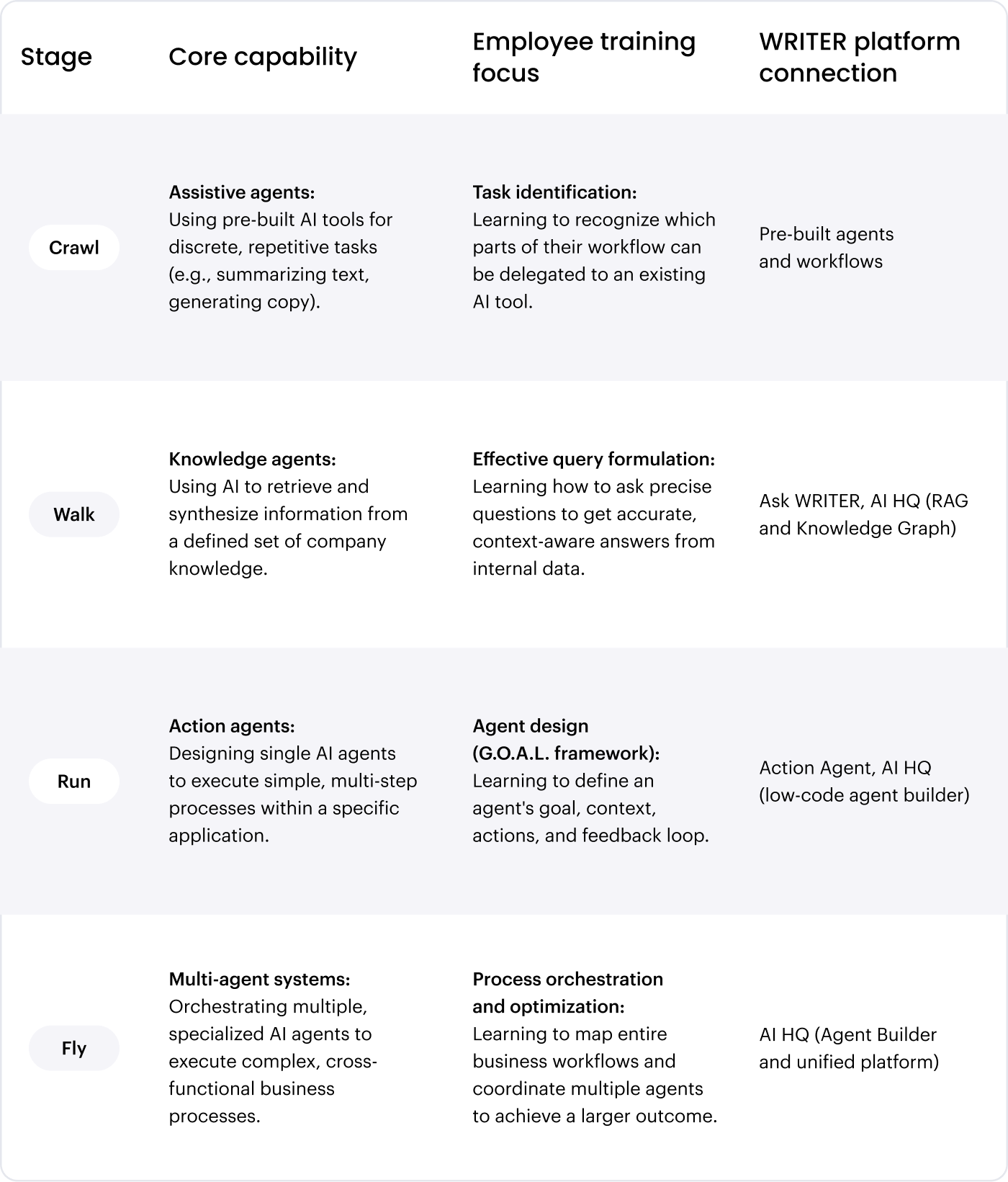
Crawl: Mastering assistive agents
The “crawl” stage is your entry point into agentic AI, focused on automating simple, self-contained tasks that don’t require external knowledge or complex reasoning. An assistive agent is a powerful tool for boosting productivity by handling high-volume, low-complexity work. This is the fastest path to demonstrating value and building organizational momentum for your AI initiatives. Your goal here is to identify and eliminate the repetitive “busywork” that consumes your team’s time.
Example: This training shifts an employee’s default behavior at common work touchpoints. For instance, instead of manually scanning a batch of standard contracts for key clauses, a legal professional gets in the habit of using an assistive agent to summarize them instantly. Similarly, a marketer — faced with a new press release — no longer defaults to writing posts from scratch but instead uses an agent to generate dozens of variations. This habit forms by repeatedly asking, “Is this a rules-based, self-contained task?” and using an agent every time the answer is yes, freeing them up for higher-value strategic work.
Employee training focus
- Skill: Task identification and automation mindset.
- Guidance: Training should focus on teaching employees how to recognize and articulate high-volume, low-risk, repetitive tasks in their own daily work. The core question to teach is: “What parts of my job are rules-based and self-contained?” This stage is less about technical skill and more about developing an “automation-first” perspective on personal productivity.
- How WRITER helps: WRITER’s extensive library of pre-built agents supports this stage. It allows teams to get immediate value by automating common tasks without any initial build effort.
Walk: Using knowledge agents
In the “walk” stage, employees move from basic understanding to applying their AI knowledge to leverage AI for more complex tasks. A knowledge agent securely connects to your internal data sources — from HR policy documents and sales records in your CRM to technical documentation in Confluence — to answer questions and provide accurate, context-aware answers. By using Retrieval-Augmented Generation (RAG), these agents can synthesize information from multiple sources to answer complex employee or customer queries, effectively breaking down knowledge silos.
Example: Forward-thinking enterprises are actively training employees to integrate AI into their daily workflows. Instead of messaging the #finance channel with a common question and waiting for a response, a knowledge agent is pinned directly to the channel. This trains employees to adopt a new habit at a key knowledge-finding touchpoint. Now, when they have a question like, “What are the deadlines for quarterly expense reports?”, they query the agent and receive an immediate, synthesized answer, complete with source links to the official finance policies for verification. This builds a more efficient, self-sufficient workforce.
Employee training focus
- Skill: Advanced querying and information synthesis.
- Guidance: Train employees on how to formulate complex questions that pull from multiple data sources. This goes beyond simple keyword searches. It involves teaching them to think about context, to ask follow-up questions, and to critically evaluate the synthesized answers and their sources. The skill is moving from a “searcher” to a “researcher.” This stage also helps employees gain a better understanding of AI’s capabilities and limitations.
- How WRITER helps: This is where the power of a platform like WRITER’s AI HQ becomes clear. By securely connecting to your internal knowledge bases — from SharePoint and Confluence to your CRM — AI HQ allows you to build knowledge agents that use RAG to provide accurate, verifiable answers based solely on your own data.
Run: Deploying action agents
The “run” phase marks a significant leap in capability, moving from retrieving information to executing tasks across multiple systems. An action agent is capable of reasoning, planning, and performing complex workflows that span different applications. Unlike traditional Robotic Process Automation (RPA) bots that follow rigid, screen-based scripts, action agents interact with systems through APIs, allowing them to adapt to changes and handle exceptions with greater resilience. Your focus during this stage is on automating end-to-end processes that are currently manual and time-consuming. As organizations adopt action agents, employees must develop new skills — particularly technical and adaptable skills — to effectively use these tools and remain competitive in a rapidly changing environment.
Example: A hiring manager no longer needs to manually navigate multiple systems to onboard a new team member. Instead, they make a single request to an action agent: “Onboard our new Senior Engineer, Jane Doe, starting next Monday.” The agent then manages the entire workflow — creating a user account in Okta, assigning a laptop through the service portal, scheduling orientation meetings in Google Calendar, and enrolling the new employee in required training modules in the LMS. Employees are trained to map these processes and interact with APIs, ensuring they can work alongside action agents to break down operational barriers — by empowering employees to execute complex, cross-system workflows on their own.
Employee training focus
- Skill: Process mapping and basic API literacy.
- Guidance: This is a significant step up. Training must focus on teaching employees to think in terms of end-to-end workflows across different systems. They need to learn how to map a business process (e.g., “onboard a client”) and identify the trigger points, data handoffs, and systems involved. While they don’t need to be developers, a basic understanding of what an API is and how systems “talk” to each other becomes essential. Employees learn to map processes and interact with APIs, bridging skills gaps and supporting automation initiatives.
- How WRITER helps: The “run” phase is precisely what AI HQ enables. Its intuitive, low-code interface empowers business users — not just developers — to build and deploy their own action agents, granting them specific tools like API access to orchestrate workflows across enterprise systems like Salesforce, Marketo, or ServiceNow.
Fly: Orchestrating multi-agent systems
The “fly” stage represents the pinnacle of agentic AI, where you orchestrate a team of specialized agents to tackle complex, dynamic business challenges. In this phase, you create a multi-agent system, or “agentic workforce,” where different agents (e.g., a knowledge agent, an action agent, and a data analysis agent) collaborate to achieve a goal that no single agent could accomplish alone. By analyzing data from multiple sources, these systems can generate meaningful insights that enhance decision-making and overall organizational performance. This is where AI transitions from a tool to a true digital team member, capable of autonomous problem-solving and strategic execution.
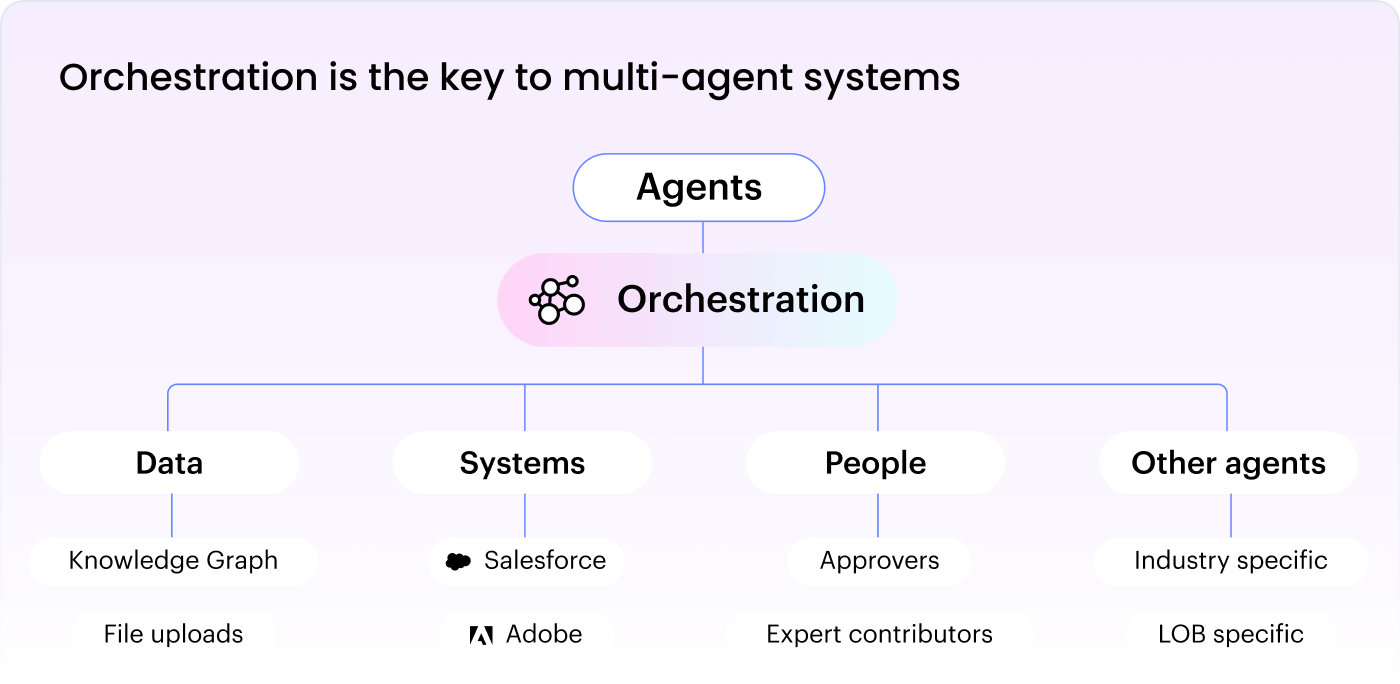
Example: When a supply chain disruption occurs, the operations manager doesn’t have to scramble. They receive a single, actionable alert — “Supplier A is delayed by 48 hours.” Instead of triggering a frantic, manual search for alternatives, the alert is a starting point. The multi-agent system has already researched alternative suppliers, analyzed their costs and lead times, and presented the best options directly to the manager.
The manager simply approves the best option. The system takes it from there, automatically initiating the new purchase order and updating the project timeline across all relevant systems. This transforms the manager’s role from reactive problem-solver to strategic decision-making.
Employee training focus
- Skill: Strategic problem-solving and system design.
- Guidance: This training is for a select group of power users and strategists. The focus is on abstract thinking — how to define a complex business problem (e.g., “reduce customer churn by 5%”) and decompose it into a set of collaborative tasks that a multi-agent system can execute. This is about designing the “team of agents” and defining their roles and communication protocols.
- How WRITER helps: On the WRITER platform, this ”agentic workforce” operates within a single, governed environment. This allows for complex, collaborative workflows where multiple agents work together, all while providing leadership with a centralized dashboard for monitoring performance, ensuring compliance, and managing security.
Uber’s journey from “crawl” to “fly”
Uber’s adoption of WRITER is a textbook example of the “crawl, walk, run, fly” framework in action. The company began in the Crawl stage by deploying assistive agents to solve a high-volume, low-complexity challenge — brand inconsistency across a massive global team. This automated brand and terminology compliance, eliminating tedious manual edits and delivering an immediate, strategic win. Building on that success, they entered the Walk stage, empowering teams to use WRITER as a knowledge agent to generate on-brand first drafts. Now, Uber is in the Run stage, using action agents to automate multi-system, multi-step processes — like their content request system — and dramatically accelerate delivery. As they build out this content engine for the future, they’re laying the foundation for the Fly stage, where orchestrated, multi-agent systems will autonomously manage entire business processes from end to end.

Empowering teams with AI agents: Learn from the real-world success of Uber
Read More
Mastering agentic AI: From operation to orchestration
For any employee, whether they’re part of pilot projects or a company-wide rollout, developing an intuitive command of agentic AI is key to using AI effectively. This isn’t about learning a single tool, but about building AI skills and a deep understanding of when and how to deploy autonomous agents to handle complex daily tasks. The goal is to weave agent-led workflows so smoothly into operations that they become second nature. It’s like how an experienced project management professional knows exactly which team member or resource to assign to a task.
Choose AI solutions that integrate with and orchestrate your existing systems
A major contributor to the success of employee adoption is your choice of agentic AI platform. The right partner provides a platform that doesn’t just add another tool to the stack, but one that securely integrates with your teams’ current software and can orchestrate workflows across them.
Look for platforms that offer strong security and governance features, allowing you to set granular permissions and maintain oversight of agent activities. The ideal partner supports the adoption process and empowers your employees to build and deploy agents that can interact with the software they already use every day. This ability to work within the existing ecosystem is how agentic AI can reach its true potential, turning it from a novelty into a core operational asset that enhances business performance.
From content generation to content lifecycle automation: An agentic workflow
Consider an organization that uses generative AI to help their marketing team draft blog posts, which significantly speeds up content creation. This is a powerful example of generative AI tools’ capabilities and represents the most value from traditional generative AI use.
Now, let’s evolve basic generative AI skills and usage into a true agentic AI workflow. Instead of just assisting with a draft, an AI agent could be tasked with managing the entire content lifecycle. The workflow would look like this:
- Objective: An employee gives the agent a clear plan — “Create a comprehensive blog post and associated social media campaign about the benefits of high-yield savings accounts for millennials, to be published next Tuesday.”
- Research and analysis: The agent autonomously performs a competitive analysis by searching the web for top-ranking articles on the topic. It identifies key themes, common questions, and SEO keywords to target using advanced data analysis capabilities.
- Content creation: Using this research, the agent drafts a well-structured, informative blog post that aligns with the voice, leveraging natural language processing to ensure quality output.
- Multi-channel asset generation: The agent then creates a series of social media posts tailored for different platforms (e.g., a professional, data-driven post for LinkedIn and a more concise, engaging post for X). It might also suggest visuals or create a short script for a promotional video, enhancing customer experiences across touchpoints.
- Staging and scheduling: Finally, the agent accesses the company’s content management system (CMS) to upload the draft blog post and connects to their social media scheduling platform to stage the social posts for final review and approval.
In this scenario, the employee’s role shifts from being a “writer” to a “strategist” who defines the goal and reviews the final output, working fewer hours on tactical execution while the agent handles the entire operational workflow.
Beyond prompting: The shift to agent design and governance
To enable these kinds of sophisticated workflows, employees need to develop AI skills that go far beyond basic prompt engineering. The newest skill in the age of agentic AI is agent design, which represents a fundamental shift in how we approach AI solutions.
To build these skills, you can train your employees using a simple framework for agent design. We call it the G.O.A.L. framework. The G.O.A.L. framework is a structured mental model for upskilling existing employees to design and delegate tasks to AI agents by defining the goal, providing operations and objects, setting assurance and approval rules, and enabling learning and logging:
- G – Goal: Define a clear and specific objective. Teach employees to articulate precisely what success looks like. Instead of “help with marketing,” a good goal is “Generate five distinct LinkedIn posts from our latest press release, targeting a senior executive audience, and stage them for review by 4 PM.” This is the first step when building an agent in WRITER’s AI HQ, where the user defines the agent’s objective in clear, natural language.
- O – Operations and objects: Before launching broad training initiatives, provide the right tools and resources. An agent is only as good as the tools it can use. Train employees to identify which “objects” (APIs, documents, databases, websites) and “operations” (web search, data analysis, file creation) the agent needs access to. WRITER operationalizes this by allowing builders to select from a secure library of pre-approved “tools” — such as web search, data analysis, or the ability to call a specific company API — and grant them to the agent.
- A – Assurance and approval: Establish guardrails and human-in-the-loop workflows. This is the governance piece. Define the rules of employee engagement — brand constraints, compliance training checks, and, most importantly, the specific points where a human must review and approve an action before finalizing it. This critical governance layer is built directly into WRITER. You can enforce brand and editorial guidelines, require citations, and design multi-step workflows that explicitly include a ‘human-in-the-loop’ approval step before an agent can execute a sensitive task.
- L – Learning and logging: Implement a feedback loop for continuous improvement. An agent isn’t a one-time setup. Train employees to review agent logs, identify failures or suboptimal outcomes, and refine the agent’s instructions (Goal, Operations, or Assurance steps) over time. WRITER provides detailed analytics and logs for every agent’s performance. This allows teams to easily identify where a process can be improved and refine the agent’s instructions for better results over time, creating a powerful feedback loop.
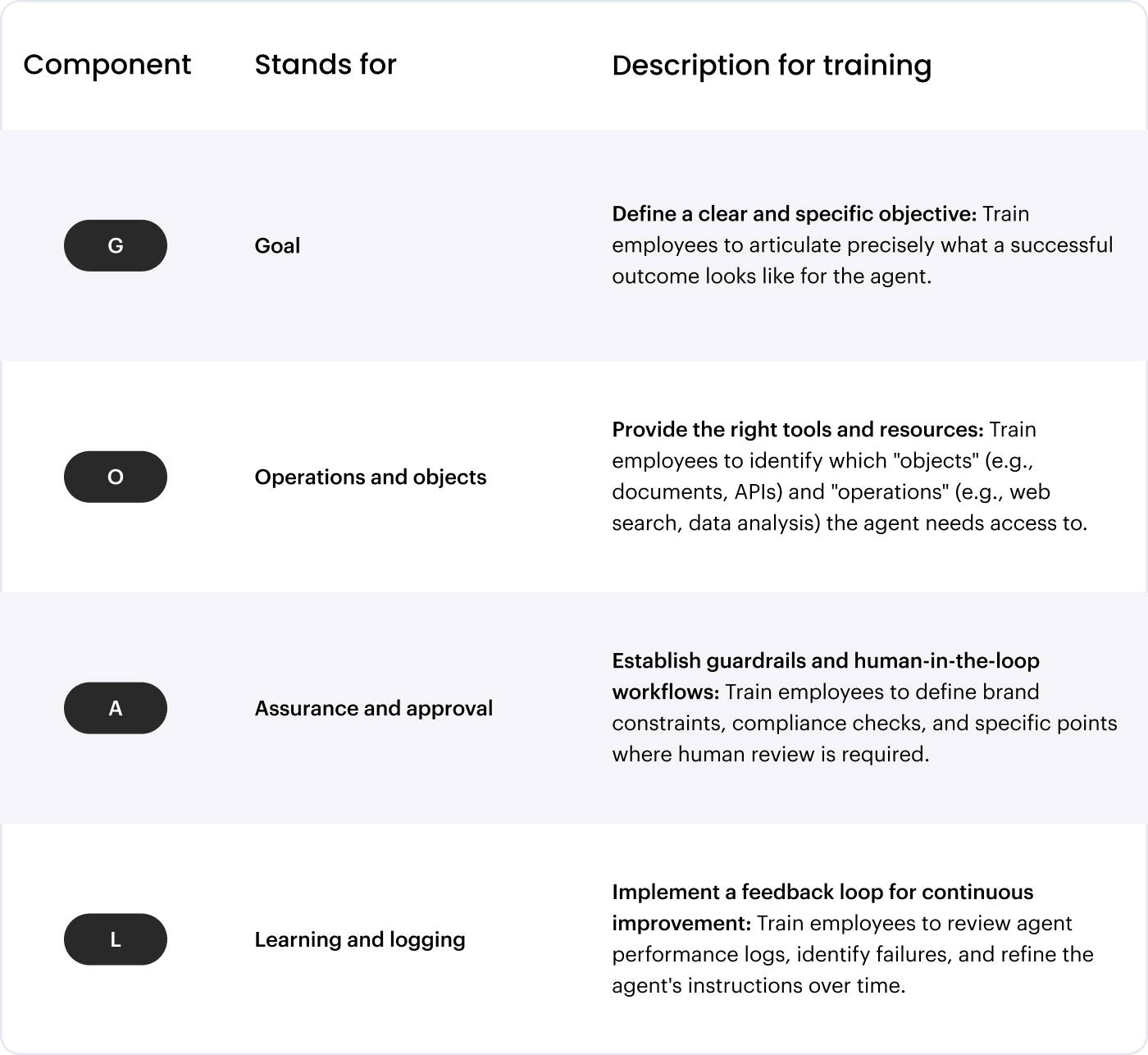
By focusing on these agent design and governance skills, you empower your workforce to move from simply using AI to actively orchestrating it, building a resilient and innovative operation ready for the AI revolution. This strategy development approach helps organizations realize the full potential of predictive AI and machine learning technologies.
Structuring your enterprise AI employee training program
A successful agentic AI rollout depends on a structured training program. Consider these three pillars.
1. Segment your audience
Not everyone needs the same level of training. Create learning paths for different personas:
- The general workforce: Focus on the “crawl” and “calk” stages. The goal is universal AI literacy and productivity.
- Power users / citizen automators: Provide deeper training into the “run” stage and the G.O.A.L. framework. These are your team champions who will build and share departmental agents.
- Technical and governance teams: Focus on the “fly” stage, API integration, security protocols, and the backend of agent orchestration.
WRITER enables this segmented approach. Granular permissions allow you to provide the general workforce with access to a curated set of “published” agents, while empowering your power users with the building capabilities of AI HQ.
2. Establish a center of excellence (CoE)
Create a central group responsible for AI governance, sharing best practices, and vetting new agents. This CoE becomes the hub for your power users and ensures that automation efforts are aligned with business strategy and security policies, not siloed.
This is where a strategic partnership is invaluable. WRITER’s dedicated customer success and solutions teams work directly with enterprise CoEs, providing the expert guidance and best practices needed to scale AI responsibly and effectively.
3. Promote a culture of experimentation (within guardrails)
Encourage employees to identify and propose new use cases for AI agents. Host internal hackathons or “automation challenges” to spur innovation. By empowering employees to build, you accelerate adoption and uncover unexpected value.
WRITER’s AI HQ acts as the perfect “sandboxed” environment for this experimentation. It empowers employees to innovate and build new solutions, while the underlying governance framework ensures that all activities remain secure, compliant, and aligned with company policy.
Building a future-ready enterprise with agentic AI: From ad-hoc adoption to intentional orchestration
The journey from “Crawl” to “Fly” is more than a technological roadmap — it’s a strategic shift from ad-hoc AI usage to the intentional orchestration of an intelligent workforce. The organizations that win in the next decade will be those that stay current with new technologies and adapt their training programs accordingly. They’ll be the ones that build a governed, scalable, and collaborative ecosystem where human talent and agentic systems work in concert. This is how you move beyond incremental productivity gains and open true competitive advantage.
As a leader, your role is not just to manage this change, but to architect it. By establishing a clear strategy, building a culture of governed experimentation, and investing in the skills of your people, you transform AI from a source of division into a catalyst for alignment and innovation. You become the builder of a more efficient, intelligent, and resilient enterprise.
Building this future requires a platform designed for the complexities of the enterprise. It demands more than a collection of disparate tools; it requires a unified AI HQ that provides the power to innovate and the confidence to scale securely.
If you’re ready to move from strategy to execution, schedule a demo to see how WRITER can help you build your agentic enterprise.
Frequently asked questions
What is an agentic AI adoption roadmap?
An agentic AI adoption roadmap is a strategic, phased plan that guides an enterprise from simple automation to complex, orchestrated AI systems. Using a “crawl, walk, run, fly” framework, it allows an organization to start with low-risk, high-value assistive agents to build momentum and prove ROI. This structured progression ensures that as the company advances toward deploying sophisticated, multi-agent systems, it does so with the necessary governance, employee skills, and technical infrastructure in place, transforming ad-hoc AI experiments into an intentional, scalable, and competitive advantage.
How do you train employees for AI agents?
AI employee training requires a structured, persona-based approach that moves beyond simple AI technology usage. For the general workforce, training focuses on AI literacy and identifying repetitive tasks suitable for pre-built agents. For power users and citizen automators, training advances to agent design, using frameworks like G.O.A.L. to teach them how to map business processes and build their own action agents. Finally, technical and governance teams receive specialized training on system integration, security protocols, and orchestrating multi-agent systems. This segmented strategy ensures all employees develop the right skills to contribute to the agentic ecosystem effectively and securely.
What is the difference between prompt engineering and agent design?
Prompt engineering is the skill of crafting a specific instruction to elicit a desired output from an AI for a single, discrete task. Agent design, however, is a far more strategic and holistic discipline required for agentic AI. It involves architecting an entire automated workflow by defining a clear goal, equipping the agent with the necessary tools and resources (like API access and knowledge bases), establishing strict governance guardrails and human approval points, and creating a feedback loop for continuous learning and improvement. In short, prompting asks the AI to do something, while agent design empowers the AI to achieve a multi-step objective.
How do you govern AI use in a large company?
Effective AI governance in a large company moves beyond simple usage policies and is built on a three-part foundation — strategy, oversight, and technology. It begins with a formal, cross-functionally developed AI strategy that provides sanctioned tools to mitigate the risks of “shadow AI.” This is supported by a central Center of Excellence (CoE) that establishes best practices, vets new automations, and ensures all efforts align with business goals. Finally, this is all enabled by a unified AI platform that provides the technical guardrails — like granular permissions, brand compliance, data privacy, human-in-the-loop workflows, and centralized logging — necessary to manage agent activity and scale innovation securely.
